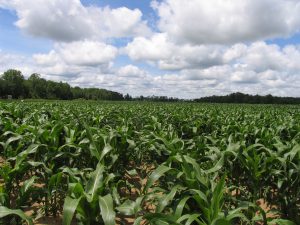How do you begin to approach wicked problems, those that span socioeconomic and ecological spheres, when solutions involve multiple and varied stakeholders? Researchers at the Kellogg Biological Station LTER began to tackle one of U.S. agriculture’s greatest challenges, excess nitrogen pollution, by hosting “The N Roundtable,” to improve the flow of information through a farming landscape that has changed dramatically in the past few decades.
As precision agriculture, big data, and private farm advisors have supplemented agricultural extension specialists, nitrogen management has become ever more complex. Trust, competing values, usability, and diffusion of innovations can play as large a role as soil chemistry, said roundtable participants.
Nutrient runoff—often caused by incomplete uptake of nitrogen fertilizer—drives increased eutrophication of lakes and streams, groundwater contamination, and increased emissions of the greenhouse gas nitrous oxide. Members of the roundtable shared a common interest in addressing these concerns and recommended several strategies—including better tailoring of decision support tools, stronger linkages between public and private advisors, and improved data sharing, but also strengthening integration of social and biophysical research.











